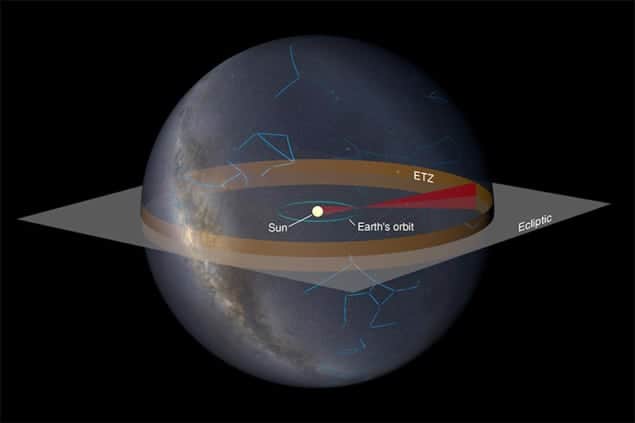
Extraterrestrial civilizations may be searching for signs of life on distant planets using the same techniques that we employ in our search for alien life. That is the key concept underlying a proposal from a duo of physicists, who want to ensure that we do not miss a possible signal from extraterrestrial observers trying to contact us. The researchers say that we should be looking for signals from extraterrestrial civilizations that could, at a previous time, have spotted Earth as it transited across the face of the Sun and realised that it could be a habitable world. The team has identified a small band in the sky from which Earth could be easily detected, and suggest that we should look for signals coming from that area.
Over the past decade or so, astronomers have discovered more than 2000 exoplanets – those that orbit stars other than the Sun – along with a further few thousand possible exoplanet candidates. Most of these exoplanets have been detected by NASA’s Kepler Space telescope using an indirect detection technique known as the transit method. Kepler looks for small, regular dips in intensity of light from a star, caused by a planet or a system of planets as they pass between the star and Earth. A similar technique, called transit spectroscopy, has allowed astronomers to study the atmospheres of exoplanets, which could hold clues about life on them, should it exist.
Perfect view
Now, Ralph Pudritz from McMaster University in Canada, together with René Heller from the Max Planck Institute for Solar System Research in Germany, have focused their attention back on Earth by presuming that extraterrestrial observers, also adopting the transit method, may have already detected the Earth. “The basic point is that the simplest way to detect the presence of a planet in orbit around a star is to detect the periodic decrease in the star’s light as the planet traverses across its disc. If you measure the percentage drop in the light of a star and observe that this repeats itself regularly, then the chances are good that the light is being blocked by a planet that orbits the star. It also tells you that you are lucky enough to be in the planet’s orbital plane around that star,” explains Pudritz, who is also the founding director of the Astrobiology and Origins of Life interdisciplinary programme at McMaster.
According to the duo, large-scale projects that hope to pick up a signal from an exoworld – such as the Breakthrough Listen initiative – should focus on the Earth’s “transit zone”. This is the region in the sky from which an observer could see the Earth as it transits less than half a solar radius from the centre of the solar disc. The possible exoplanetary systems that enjoy this view are all located in a small strip in the sky that is defined by the projection of the Earth’s orbit around the Sun (the ecliptic) onto the celestial sphere.
An observer could essentially only see a dimming effect if they remained within this zone. “You have to be very close to the midplane of that orbital zone as is shown on the diagram [see above],”says Pudritz, adding that “different observers in the galaxy would see this at different times in Earth’s year as the Sun, and the Earth with it, moves through their night skies.”
Although the transit zone amounts to only about two-thousandths of the entire sky, it is rich in host stars for planetary systems. Indeed, there are approximately 100,000 systems, each of which could include habitable planets or moons, according to the duo. The researchers compiled a list of 82 nearby Sun-like stars that satisfy their criteria. This catalogue can now serve as an immediate target list for SETI initiatives. The team says that if any of these planets host intelligent observers, they could already have identified Earth as habitable, and decided that ours is a rocky world worth probing. Furthermore, we could be receiving their broadcasts today.
See me see you
Some of the exoworlds that lie within our transit zone could also be detected by the European Space Agency’s Planetary Transits and Oscillations of stars (PLATO) mission, scheduled for 2024. “PLATO might even detect the transits of exoplanets, whose possible inhabitants would be able to see the Earth transiting the Sun,” adds Heller, who is also part of the mission. “Such a crazy set-up would offer both them and us the possibility of studying each other’s planets with the transit method.”
Pudritz and Heller told physicsworld.com that their research has further developed “an important idea about how we might build on decades worth of pioneering SETI searches by employing a potentially more powerful search strategy for detecting transmission from extraterrestrial intelligent sources”.
The work will be published in Astrobiology (doi:10.1089/ast.2015.1358).



